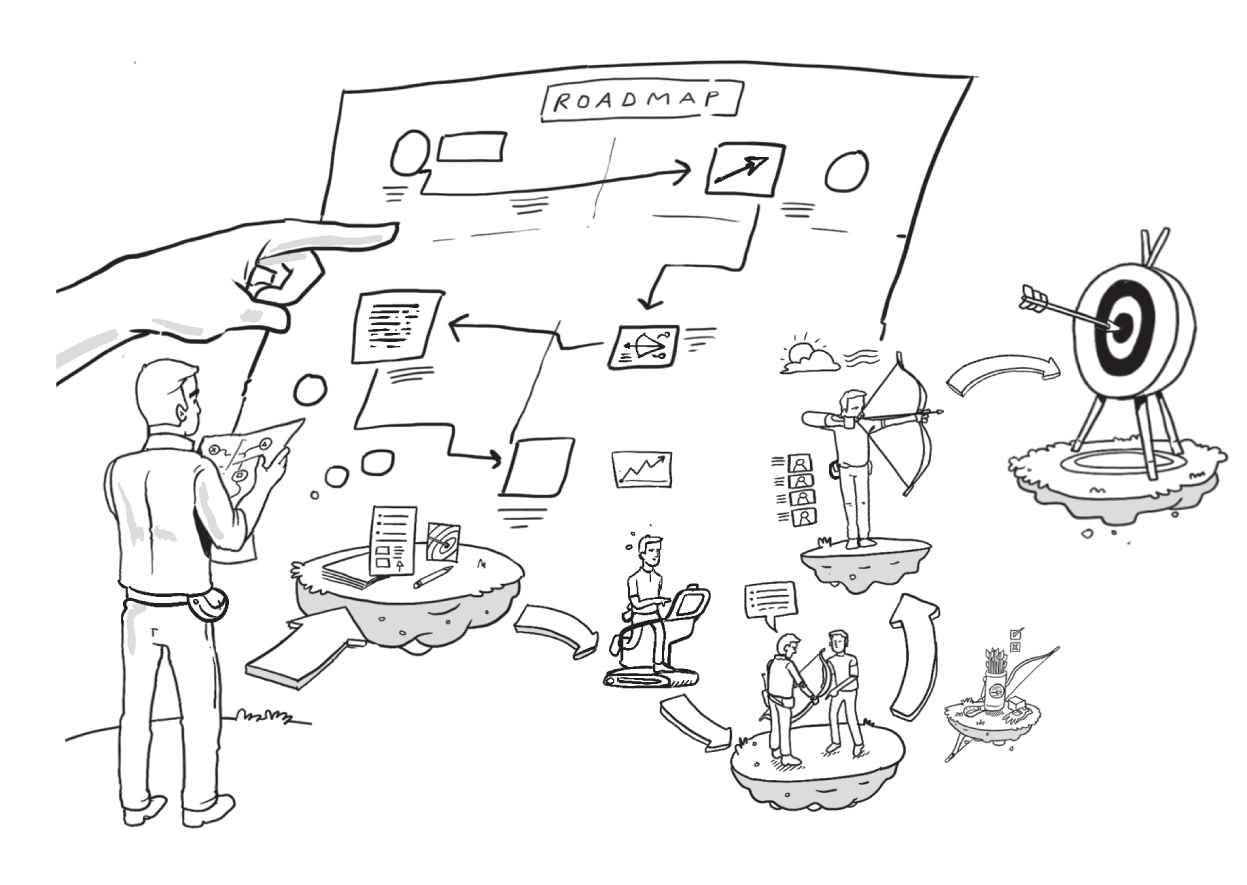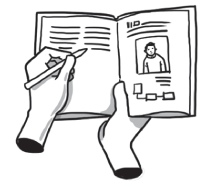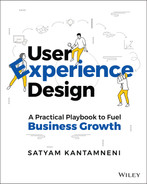CHAPTER 19
EXPERIENCE ROADMAP PLAY: How do I create a roadmap centered around the experience of a user?
A clunky and frustrating end‐user experience is the product of a siloed or inefficient organization. To mitigate that, an entire organization has to come together and collaborate cross‐functionally by placing the user at the center of their world. An experience roadmap facilitates a clear and deliberate path that unites the entire organization. Grounded in insights, the experience roadmap play is a critical guide telling you what to focus on, when you should focus on it, and why.

Who Are the Key players in the Experience Roadmap play?
| ROLE | WHO’S INVOLVED | RESPONSIBILITIES |
|---|---|---|
 DRIVER |
|
|
 CONTRIBUTOR |
|
|

THE HOW
To build an effective experience roadmap, you need to be mindful of:
1. Your USERS and Systems
Who are the users that matter most to the success of your business? Your users include your customers, of course, but they also include others involved in the entire experience ecosystem: suppliers, employees, and partners (see Chapter 18: “Experience Ecosystem Play”).
One of the biggest mistakes organizations make is focusing solely on paying customers and neglecting the employees who help troubleshoot, onboard, and interact with those customers and each other. A great user experience neither begins nor ends when customers buy your product. Instead, it is made up of the myriad interactions and touchpoints that customers experience with your larger organization—from the moment they first discover your product to the moment they are no longer a customer. These moments are made possible by your employees, partners, and suppliers. That’s why it’s critical to include these stakeholders as you define the users that matter most to your business.
2. Defining the EXPERIENCES and SCENARIOS Your Users Have within Your System
Prioritize the users that your organization wants to understand and for whom you want to orchestrate experiences. Once you’ve prioritized them, identify all the experiences and scenarios that matter.
Experiences: An experience is an event or occurrence that leaves an impression throughout the user’s life cycle with your organization. Experiences matter to your user or business, and when designed well, a great experience can have a magnified effect on your organization’s success.
If you have trouble identifying whether something is an experience, apply the test below. If it meets all three criteria, treat it as an experience.
- Is this an important theme for your user or business?
- Does it have a substantial scope?
- Can you measure it?
Scenarios: Users move through many different individual scenarios in their overall experience of achieving (or not) their intended goal. Identify and record all of the possible scenarios in the experience you are evaluating.
Scenarios can be multi‐medium, ranging from no‐tech (e.g. friends, magazines) to higher‐tech (e.g. computers, iPads, voice). To design a holistic and consistently superior user experience, all scenarios and accompanying modality need to be accounted for and designed.
3. Extracting Business and User INSIGHTS
Extract and map key business and user insights for each of the experiences defined above.
Key business insights across the customer life cycle typically fall into the following categories:
- Adoption: conversion rates, customer acquisition cost (CAC), revenue per user (RPU);
- Satisfaction: net promoter score (NPS), customer satisfaction score (CSS);
- Engagement: drop‐off rates;
- Efficiency: cost/effort per experience;
- Retention: renewal rates.
Key user insights are the actions, soundbites, observations, and research gathered directly from the user. These insights can include things that your user likes, dislikes, needs, feels, wants, clicks on, or does (Chapter 28: “Experience Metrics Play”).
4. Planning for PRIORITIZATION of Experiences and Minimum Viable Experiences (MVEs)
In order to prioritize, consider your larger business goals. These could include:
- Adoption (get new users);
- Satisfaction (get more satisfied users who would recommend the product);
- Retention (keep existing users);
- Engagement (deepen engagement among current users);
- Efficiency (help users accomplish the same task faster).
Triangulate your business and user insights you extracted with your business goals and objectives. This will help you surface the most user‐ and business‐critical experiences to tackle in a defined time frame. Then, prioritize the experiences based on time frame, impact, and feasibility. The top experience(s) are the one all teams need to tackle together in a given time frame.

Identify your minimum viable experiences (MVEs) and prioritized scenarios for each experience. An MVE takes into consideration the user’s experiences across the entire journey and ensures that at least one deliberate scenario has been designed across all experiences in the users’ journey.
The levels above MVE are more enhanced experience (MEE) and most transformed experience (MTE). Review Chapter 32: “Experience Benchmarking Play,” which describes these levels in more detail.
5. Fostering COLLABORATION across Functional Silos
Bring the whole organization together when you are designing for the MVE and MTE. If you are working on perfecting your onboarding experience, involve the sales, implementation, and customer success teams to ideate, gather insights, seek feedback, and collaborate. A great user experience doesn’t stop at one particular point. Your job is to orchestrate and bring together the needed parties to deliver a transformed product experience.
IN ORDER TO MAXIMIZE THE VALUE OF THIS PLAY
- Create an experience roadmap for each user who matters to your business;
- Make sure that each experience roadmap has an owner—either an experience strategist or another designated person;
- Aim to finalize the experience roadmap in the first 90 days of defining the experience vision;
- Expand the roadmap to account for variations in user contexts and technology modalities under each experience;
- Document the experiences horizontally to identify any possible relationships, overlaps, or clashes;
- Use the measuring experience metrics play to help define your experience metrics.
 RELATED PLAYS
RELATED PLAYS
- Chapter 14: “User Empathy Play”
- Chapter 28: “Experience Metrics Play”
- Chapter 29: “Insights Curation Play”
